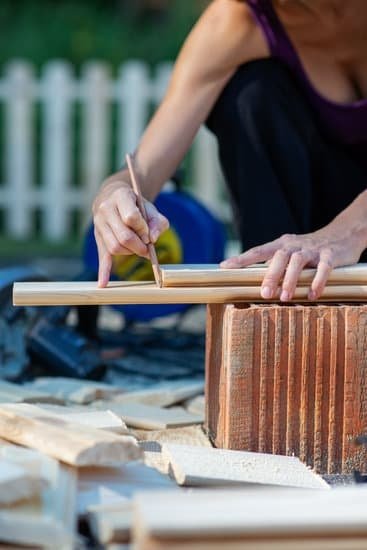Woodworking requires precision and attention to detail. One essential aspect of achieving accurate and efficient results is marking your woodworking projects. Whether you’re a seasoned woodworker or just starting out, proper marking is crucial to ensure that your measurements are accurate, your joints fit together perfectly, and your finished product meets your expectations. In this article, we will explore the importance of marking in woodworking and provide you with valuable insights on how to mark your projects effectively.
When it comes to marking tools, selecting the right ones can make all the difference. From pencils and markers to knives and chisels, there are various options available for different marking needs. We will delve into the advantages of each type of tool and help you choose the ones that are best suited for your specific project.
Different types of wood markings serve distinct purposes in woodworking. Surface marking helps identify cuts, while joint marking ensures precise alignment when joining pieces together. Layout marking involves drawing guidelines for overall design and component placement. Understanding these various techniques is essential for successful woodworking projects, and we will provide detailed explanations and tips for each.
Before you start marking your woodwork, it’s important to prepare the surface properly. Sanding, cleaning, and applying sealants not only contribute to a smoother finish but also facilitate accurate marking. We will guide you through the necessary steps to ensure that your wood is in optimal condition for marking.
By learning about different marking techniques and using appropriate measuring and layout tools, such as tape measures, squares, or bevel gauges, you can achieve precise results in every aspect of your woodworking project. Additionally, incorporating templates and jigs can further enhance accuracy when repeating patterns or working on complex designs.
In this article, we’ll provide best practices for effective wood marking techniques that include maintaining light pressure while marking consistently parallel lines along reference points. We’ll also address troubleshooting tips for common mistakes like misalignments or smudging.
Marking may seem like a minor aspect of woodworking, but it is a fundamental step that significantly impacts the final outcome. Whether you’re building furniture or crafting smaller items, accurate and efficient marking will elevate your craftsmanship to new heights. So, let’s dive in and discover the essential techniques, tips, and tools that will revolutionize how you mark your woodworking projects.
The Importance of Choosing the Right Marking Tools
In woodworking, choosing the right marking tools is essential for achieving accurate and efficient results. The type of marking tool you use can greatly impact the precision and quality of your woodworking projects. There are several different types of marking tools available, each with its own advantages and uses.
One common type of marking tool used in woodworking is a pencil. Pencils provide versatility and are suitable for a wide range of applications. They come in various lead hardness options, allowing you to choose the appropriate pencil for different types of wood. Pencils are great for surface marking as they create clean, easily visible lines that can be easily erased or sanded away when needed.
Another popular marking tool is the marking knife. Marking knives have a sharp, pointed tip that allows you to make precise cuts in the wood’s surface. They are ideal for joint marking, where accuracy is crucial for proper alignment and fitting. Marking knives create crisp and accurate lines that can serve as reference points during the woodworking process.
For layout marking, especially when working with larger pieces or complex designs, consider using a marking gauge. A marking gauge allows you to mark consistent distances from an edge or reference line. By adjusting the gauge’s fence or blade position, you can achieve consistent spacing for multiple marks across your project.
Other useful marking tools include mortise gauges for accurately measuring and locating mortises, awls for starting holes or creating dimples in wood surfaces, and combination squares for measuring angles and checking squareness.
When selecting your marking tools, consider factors such as durability, ease of use, accuracy, and your personal preferences. It’s always helpful to have a variety of tools on hand so that you can choose the most appropriate one depending on your specific needs.
By choosing the right marking tools for your woodworking projects, you’ll be able to achieve more accurate measurements and markings. This will not only save time but also ensure that your pieces fit together properly and look professional. Experiment with different marking tools to find the ones that work best for you, and remember to keep them well-maintained and sharp for optimal performance.
Understanding Different Types of Wood Marking
Wood marking is an essential aspect of woodworking that involves making precise and accurate markings on the wood to guide the cutting, shaping, and assembly processes. Understanding the different types of wood marking techniques is crucial for achieving desired outcomes in various woodworking projects. This section will explain the various marking techniques used in woodworking, including surface marking, joint marking, and layout marking.
Surface Marking
Surface marking involves making markings directly on the surface of the wood to indicate measurements, reference lines, or other important information. It is typically done using a pencil or a marker. Surface markers are ideal for general-purpose marking as they provide clear visibility and can be easily erased or sanded off when no longer needed. When using a pencil for surface marking, it is advisable to use a sharp one to ensure fine and precise lines.
Joint Marking
Joint marking is crucial for ensuring accurate joinery in woodworking projects. It involves making markings on mating surfaces to guide the cutting and fitting of joints such as mortise and tenon, dovetail, or finger joints. For joint marking, traditional tools like marking gauges and mortise gauges are commonly used.
These tools enable woodworkers to mark consistent and parallel lines along the edges of their workpieces. A marking gauge consists of a beam with an adjustable fence or pin that can be set at a specific distance from the edge of the wood. A mortise gauge has two pins that can be adjusted to mark both edges simultaneously.
Layout Marking
Layout marking refers to establishing layout lines or patterns on the wood surface for precise cutting or shaping purposes. It is commonly used when creating intricate designs, curves, or complex joints. Layout tools such as compasses, dividers, squares, bevel gauges, and templates are used in this type of wood marking technique. These tools help achieve accuracy by allowing woodworkers to transfer measurements, angles, and curves from their plans or templates onto the wood.
Understanding these various marking techniques is essential for woodworkers to execute their projects with precision and efficiency. Each technique serves a different purpose and requires specific tools and skills. By mastering the art of wood marking, woodworkers can ensure accurate measurements, clean cuts, and seamless joinery in their projects.
Preparing Your Woodwork for Marking
Before you begin marking your woodworking project, it is essential to properly prepare the wood for accurate and clean markings. Taking the time to prepare your woodwork will not only improve the visibility of your marks but also prevent any imperfections or damage that may occur during the marking process. Here are some necessary steps to ensure your wood is ready for marking:
- Sanding: The first step in preparing your wood for marking is sanding. Sanding helps create a smooth surface by removing any rough patches or irregularities on the wood’s surface. It ensures that your markings will be more even and consistent throughout the project. Start with a coarse-grit sandpaper and gradually move to finer grits until you achieve the desired level of smoothness.
- Cleaning: After sanding, it is crucial to clean the wood thoroughly to remove any dust or debris that may have accumulated during the sanding process. Use a vacuum cleaner or a tack cloth to remove all particles from the surface, ensuring a clean and clear canvas for marking.
- Applying Sealants: Depending on the type of project and wood you are working with, applying a sealant may be necessary before marking. Sealants help protect the wood from stains, moisture damage, and warping. Additionally, they provide an even surface for your markings and prevent bleeding into the surrounding areas. Choose a suitable sealant based on your project requirements and apply it evenly using a brush or cloth.
By following these necessary steps of sanding, cleaning, and applying sealants, you can ensure that your woodworking project is properly prepared for marking. This preparation not only enhances visibility but also improves accuracy when making measurements or laying out joints on your workpiece.
Choosing the Right Marking Technique for Your Project
When it comes to woodworking, choosing the right marking technique is crucial for ensuring accuracy and achieving the desired outcome. Different projects require different methods of marking, and understanding which technique to use can greatly improve efficiency in your work. Here, we will guide you through the process of selecting the appropriate marking technique based on the type of project and your desired outcome.
Surface Marking
Surface marking involves creating visible lines or marks directly on the surface of the wood. This technique is commonly used for tasks such as indicating where to make cuts or drilling holes. Some common tools for surface marking include pencils, markers, or tracing wheels.
Pencils are versatile because they can be easily erased if adjustments need to be made, while markers provide darker and more permanent lines. Tracing wheels are useful for transferring patterns onto wood but may not be as precise as a pencil or marker.
Joint Marking
For joinery work, accurate markings are essential to ensure that pieces fit together properly. Joint marking techniques help create precise cuts and lines for accurate joinery. Tools commonly used for joint marking include combination squares, mortise gauges, dovetail markers, or knife blades.
Combination squares are versatile and can be used for measuring as well as marking 90-degree angles. Mortise gauges allow you to mark consistent depths for mortises, while dovetail markers help create precise angles for dovetail joints. Knife blades are also frequently used for scoring lines along grain fibers.
Layout Marking
Layout marking refers to creating layout lines that guide subsequent operations during woodworking projects. This can include indicating where hardware should be placed or positioning parts before assembly. Some common tools for layout marking include tape measures, rulers, sliding bevels, or story sticks. Tape measures and rulers provide accurate measurements when creating layout lines while sliding bevels help transfer angles onto the workpiece. Story sticks are useful for recording measurements that need to be duplicated or referenced later.
By understanding the different marking techniques available and selecting the appropriate tools for each, you can ensure accuracy and efficiency in your woodworking projects. Remember to consider the type of project you are working on and the desired outcome when choosing a marking technique. With practice and attention to detail, your woodworking markings will consistently be precise, leading to better-quality results.
Using Measuring and Layout Tools for Precision
Accurate measuring and layout are essential in woodworking to ensure precise and professional results. By utilizing the right tools and techniques, woodworkers can achieve the level of precision necessary for their projects. This section will provide tips and tricks for using measuring and layout tools effectively.
One of the most common tools used in woodworking is a tape measure. When using a tape measure, it’s important to ensure that it is fully extended and straight before taking measurements. It’s also helpful to use a tape measure with large, easy-to-read markings for better accuracy. Additionally, marking reference lines on the wood before making cuts or joinery can help guide measurements and prevent mistakes.
Squares are another crucial tool for achieving precise measurements and layouts. A combination square, which has a ruler blade and an adjustable square head, is versatile and useful in many woodworking tasks. To ensure accurate measurements with a square, make sure that its blade is positioned securely against the edge of the wood. It’s also helpful to check for squareness by flipping the square over or using contrasting background colors to identify any discrepancies.
Bevel gauges are particularly useful when working with angles or chamfers in woodworking projects. These tools can be adjusted to match existing angles or transfer specific angles from one piece of wood to another. When using a bevel gauge, make sure it is locked securely to prevent any movement while marking or cutting angles.
| Tool | Tips and Tricks |
|---|---|
| Tape Measure | – Fully extend and straighten before taking measurements – Use a tape measure with large, easy-to-read markings. – Mark reference lines on wood before making cuts or joinery |
| Squares | – Position blade securely against wood edge – Check for squareness by flipping the square over or using contrasting colors |
| Bevel Gauges | – Adjust to match existing angles or transfer angles between wood pieces – Lock securely to prevent movement during marking or cutting angles |
By using measuring and layout tools correctly and following these tips, woodworkers can achieve precision in their projects. Accurate measurements pave the way for precisely cut pieces, tight-fitting joinery, and overall high-quality woodworking. Taking the time to master the proper use of these tools will greatly contribute to the success and satisfaction of any woodworking project.
Incorporating Templates and Jigs in Wood Marking
Templates and jigs are valuable tools in woodworking that can greatly enhance the accuracy and consistency of your markings, particularly when working on projects with repeated patterns or complex designs. These tools act as guides, ensuring that you achieve precise and uniform markings every time.
A template is a pre-cut piece of material, often made from wood or plastic, that is used to replicate a specific shape or pattern. By tracing along the template with a pencil or marking knife, you can easily transfer the design onto your workpiece. Templates are commonly used for creating curves, circles, and intricate details like rosettes or scrollwork.
Jigs, on the other hand, are devices that hold your workpiece securely in place while guiding your cutting or marking tools. They help eliminate human error and ensure consistent results by controlling the movement of your tools along predetermined paths. Jigs can be as simple as a block of wood with guide holes for drilling precise dowel holes or as complex as a router jig for creating intricate joinery.
Using templates and jigs not only saves time but also improves efficiency by eliminating the need to measure and mark each individual piece separately. They provide a reliable reference point that you can use repeatedly throughout your project to achieve consistent results. Additionally, templates and jigs are especially helpful for beginners who may struggle with freehand marking techniques.
When incorporating templates and jigs into your woodworking projects, it’s important to ensure they are accurately positioned and securely attached to your workpiece. Double-check their alignment before proceeding with any cutting or marking operations. It’s also recommended to label your templates clearly so that you can easily identify which one corresponds to each specific shape or detail in your project.
Best Practices for Marking Your Woodworking Projects
One of the most important aspects of marking your woodworking projects is using proper technique. By employing best practices, you can ensure accuracy and efficiency in your wood markings. The following are some practical tips to keep in mind when marking your woodworking projects.
First and foremost, it is crucial to apply light and even pressure when making marks on your wood. Applying too much pressure can cause the tool to slip, leading to inaccurate results. Additionally, excessive pressure can also leave deeper marks on the wood, which may be difficult to remove later on. By applying a gentle and consistent amount of pressure, you will achieve clean and precise markings.
Utilizing reference lines is another important practice when marking your woodworking projects. Reference lines serve as guides for consistent measurements and alignments. Before marking, carefully measure and mark out appropriate reference lines on your wood. These lines will help you maintain consistency throughout your project and ensure accurate positioning of joints or other elements.
Maintaining cleanliness on your wood surface is crucial for good visibility during marking. Any debris or dust particles present on the wood can make it difficult to see markings properly, leading to potential errors or inaccuracies. It is advisable to clean the wood surface thoroughly before marking by either blowing off any dust or wiping it with a clean cloth.
By implementing these best practices in your woodworking projects, you can significantly improve the accuracy and efficiency of your markings. Remember, light and even pressure, utilizing reference lines, and maintaining cleanliness are key factors that will contribute to successful results in all your woodworking endeavors.
Troubleshooting Tips and Common Mistakes to Avoid
Wood marking can be a delicate process, and even the most experienced woodworkers may encounter challenges along the way. In this section, we will address some common troubleshooting tips and offer solutions for avoiding common mistakes that can occur during wood marking.
One of the most frustrating issues that woodworkers face is misalignments in their markings. This can happen when the marking tool slips or when there is human error in positioning. To avoid this, it is crucial to use a steady hand and maintain a firm grip on your marking tool. Taking your time and double-checking your measurements before making any marks can also help prevent misalignments.
Another issue that commonly arises during wood marking is smudging. This can happen if excess ink or graphite from your marking tool rubs off onto the surface of the wood. To minimize smudging, use light pressure when making your marks, as excessive pressure can cause the ink or graphite to spread. Additionally, consider using markers or pencils with quick-drying ink to reduce the chances of smudging.
Misreading measurements can also lead to inaccuracies in your wood markings. Double-checking your measurements before making any marks is essential, but it’s also important to ensure that you have clear visibility of the measurement lines. Wiping away any sawdust or debris from the surface of the wood and positioning yourself in good lighting conditions can make a significant difference in preventing misreadings.
By being aware of these common challenges and following these troubleshooting tips, you can avoid many mistakes that might arise during wood marking. Remember to take your time, practice proper technique, and double-check everything before making any permanent marks on your woodworking projects.
Conclusion
In conclusion, marking your woodworking projects is crucial for achieving accuracy and efficiency in your craftsmanship. Throughout this article, we have highlighted the various aspects of wood marking, from choosing the right marking tools to understanding different techniques for surface marking, joint marking, and layout marking.
One key takeaway is the importance of selecting the appropriate marking technique for your specific project. Whether it’s using a pencil or knife for surface marking or utilizing templates and jigs for consistent markings, each method plays a vital role in ensuring precise and consistent results. Additionally, incorporating measuring and layout tools such as tape measures, squares, and bevel gauges can greatly enhance precision.
Moreover, this article has provided practical advice on best practices for marking your woodworking projects. Remember to apply light and even pressure when making marks, utilize reference lines for accuracy, and maintain cleanliness on both your workpiece and tools to ensure clear visibility. By following these guidelines, you can avoid common mistakes such as misalignments, smudging, and misreading measurements.
Overall, marking is an essential step that should not be overlooked in woodworking. It serves as the foundation for accurate cuts and joints while allowing you to achieve consistent results throughout your projects. So remember to take the time to prepare your woodwork properly, choose the right tools and technique for each task, and employ best practices to ensure improved accuracy and efficiency in all your woodworking endeavors.

Hi everyone! I’m a woodworker and blogger, and this is my woodworking blog. In my blog, I share tips and tricks for woodworkers of all skill levels, as well as project ideas that you can try yourself.





